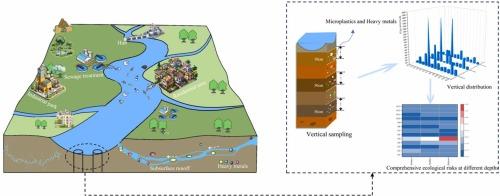Co-occurrence of microplastics and heavy metals to urban river sediments: the vertical distribution characterization and comprehensive ecological risk assessment
IF 12.2
1区 环境科学与生态学
Q1 ENGINEERING, ENVIRONMENTAL
引用次数: 0
Abstract
Microplastics (MPs) and heavy metals (HMs) are deemed to pose ecological risks in river ecosystems. The vertical distribution of these pollutants is more conducive to reflecting pollution status and monitoring trends in the sediment. This work analyzed the horizontal and vertical distribution, carried out a risk assessment of HMs and MPs in urban river sediment, and further optimized the two-dimensional comprehensive index (TPI) model for MPs-HMs combined pollution. The highest rates of contamination were for Zn, As, and Cd, and MP abundance in sediment ranged from 20.00 ± 8.82 to 1933.33±141.42 items·kg−1, mainly characterized by PE and fragments. Moreover, the mean potential ecological risk index for MPs (PRI) at different depths of sediment were 197.21±247.14, 176.79±293.86, and 246.98±538.38, respectively, indicating a moderate risk and the highest PRI value is at the bottom. The TPI exhibited that the average TPI at different depths is 324.10±138.63, 368.30±157.13, and 481.88±296.05, indicating that the comprehensive pollution risk level belongs to considerable, the TPI increases with the depth of the sediment. The results further improved the objectivity and accuracy of the research on the ecotoxicity of compositive pollutants and provided an in-depth understanding of MPs and HMs in urban freshwater basins from a vertical perspective.

求助全文
约1分钟内获得全文
求助全文
来源期刊

Journal of Hazardous Materials
工程技术-工程:环境
CiteScore
25.40
自引率
5.90%
发文量
3059
审稿时长
58 days
期刊介绍:
The Journal of Hazardous Materials serves as a global platform for promoting cutting-edge research in the field of Environmental Science and Engineering. Our publication features a wide range of articles, including full-length research papers, review articles, and perspectives, with the aim of enhancing our understanding of the dangers and risks associated with various materials concerning public health and the environment. It is important to note that the term "environmental contaminants" refers specifically to substances that pose hazardous effects through contamination, while excluding those that do not have such impacts on the environment or human health. Moreover, we emphasize the distinction between wastes and hazardous materials in order to provide further clarity on the scope of the journal. We have a keen interest in exploring specific compounds and microbial agents that have adverse effects on the environment.
 求助内容:
求助内容: 应助结果提醒方式:
应助结果提醒方式:


